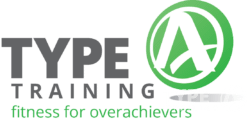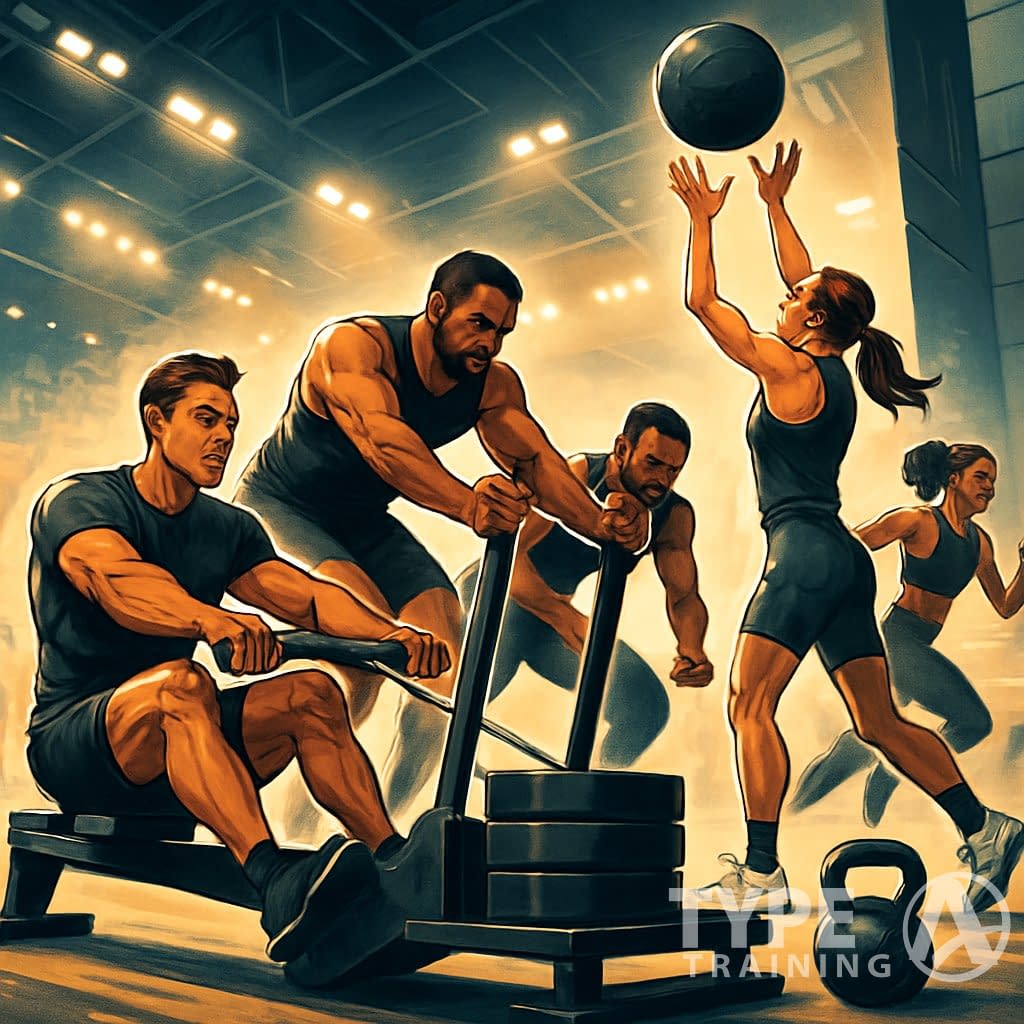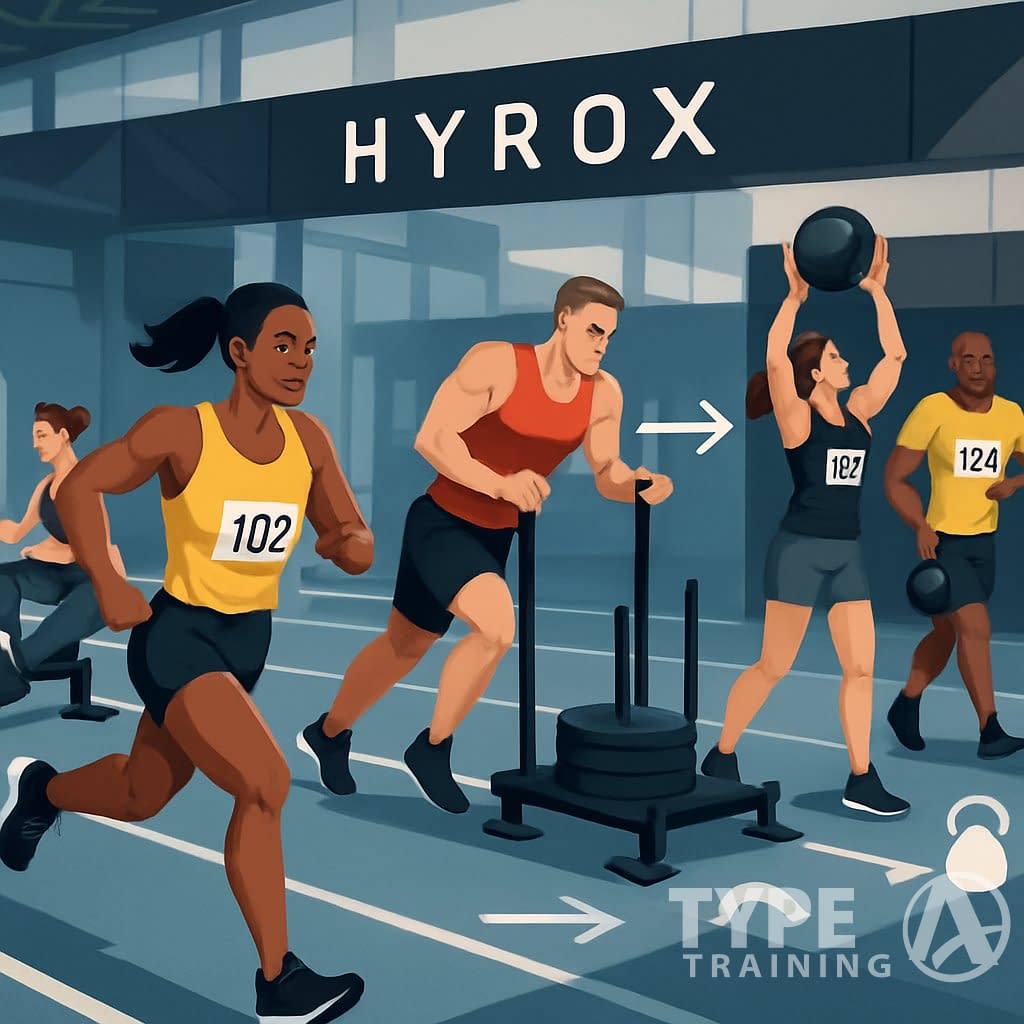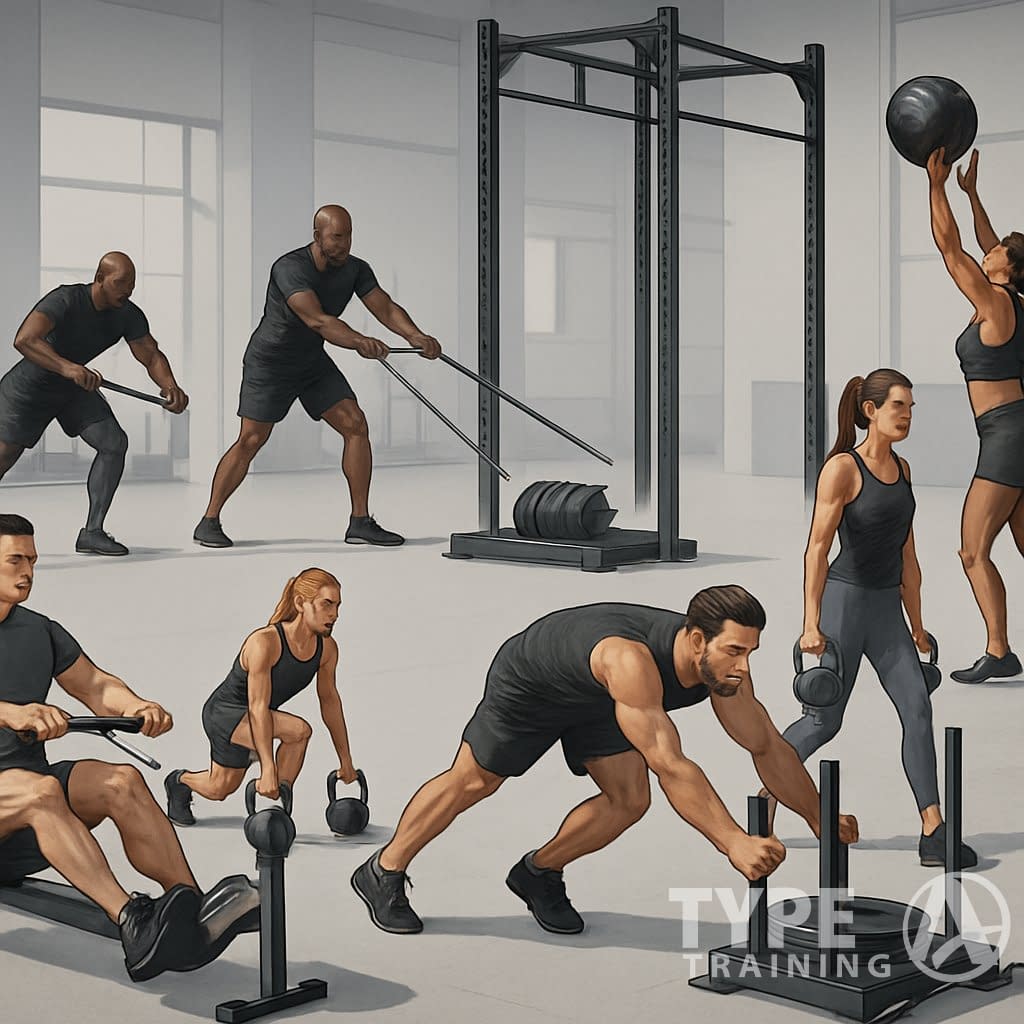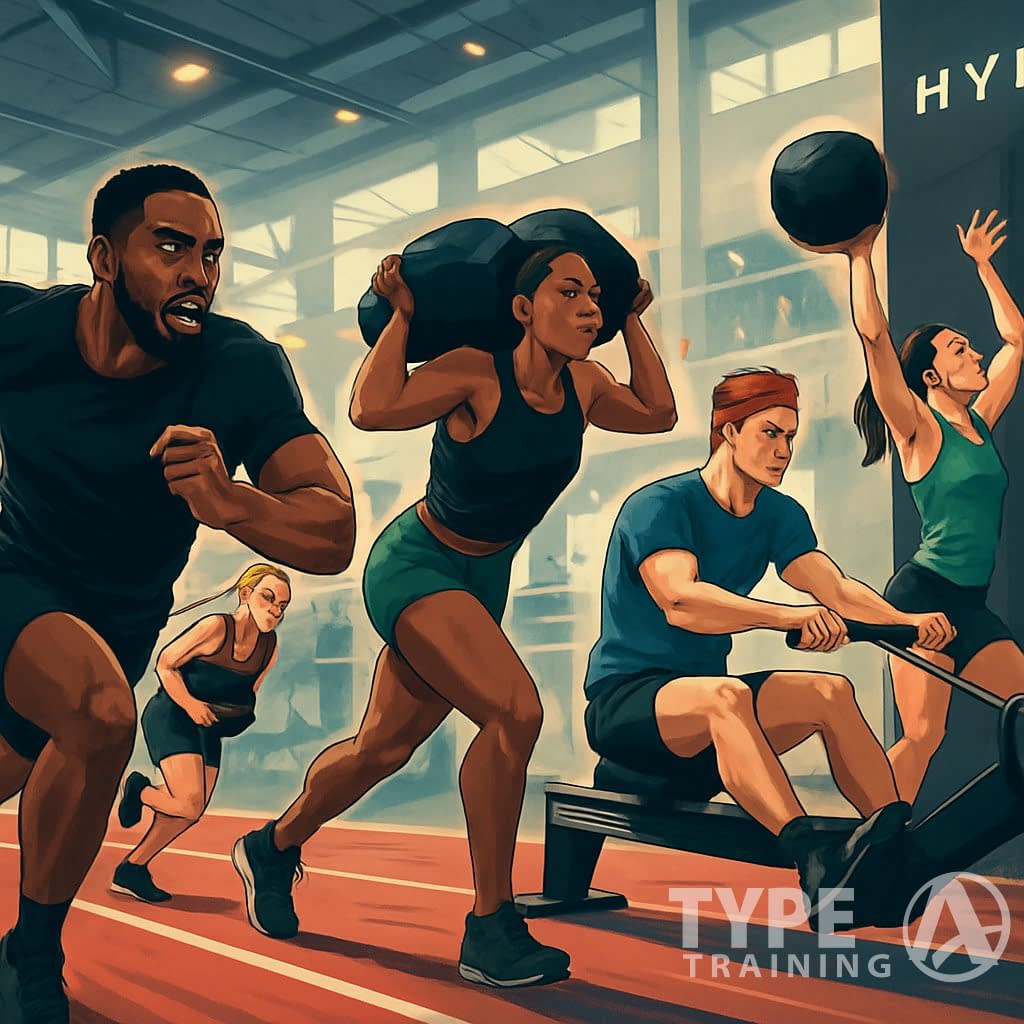HYROX has exploded in popularity lately. It’s a fitness event that mixes running and workout stations, putting both your endurance and strength to the test.
What Is HYROX? This fitness race is perfect for those wanting to push their limits.
HYROX is the world’s fastest-growing fitness race because it’s for everyday athletes, but it still pushes the best to their limits.
Understanding What Is HYROX is essential for anyone interested in fitness.
Popular posts:

You don’t have to be a pro to join in. The race welcomes all fitness levels, with divisions that keep it accessible but still competitive.
The key to knowing What Is HYROX lies in its inclusive structure.
There’s a mix of running, rowing, sled pushes, and other functional moves. It’s a real test of overall fitness, not just one specialty.
Maybe what really sets HYROX apart is the community vibe. You train, compete, and share the whole thing with thousands of others around the globe.
Community support plays a vital role in understanding What Is HYROX.
That shared challenge has people calling HYROX more than a race—it’s turning into a fitness culture all its own.
Key Takeaways
- HYROX combines running and functional workouts in a set race format
- The event is open to all fitness levels with multiple divisions
- Community and culture play a major role in its rapid growth
What Is HYROX?
HYROX is a global fitness competition that blends endurance running with functional strength exercises.
What Is HYROX? It’s a global fitness event that challenges your abilities.
Every HYROX race uses the same format worldwide, so you can compare your results no matter where you show up.
To grasp What Is HYROX, participate in a race and experience it firsthand.
A HYROX event includes 8 rounds of running and 8 workout stations. You start with a 1 km run, hit a workout, and repeat until you’re through all 8 rounds.
The last thing you’ll do? Wall balls. Always.
Here’s the basic structure:
| Segment | Distance/Exercise |
|---|---|
| Run 1 | 1 km |
| Station 1 | SkiErg |
| Run 2 | 1 km |
| Station 2 | Sled Push |
| Run 3 | 1 km |
| Station 3 | Sled Pull |
| Run 4 | 1 km |
| Station 4 | Burpee Broad Jumps |
| Run 5 | 1 km |
| Station 5 | Rowing |
| Run 6 | 1 km |
| Station 6 | Farmer Carry |
| Run 7 | 1 km |
| Station 7 | Sandbag Lunges |
| Run 8 | 1 km |
| Station 8 | Wall Balls |
You can compete solo, with a partner, or as part of a relay team. The weights and distances shift a bit by division, but the format never changes.
What Is HYROX? It’s a unique competition blending fun and fitness.
HYROX keeps things standardized, so you can track your progress over time and stack your results up against athletes from anywhere. That consistency is a big part of what makes HYROX different.
HYROX Explained: Origin, Race Format, and Why It’s So Popular in Fitness
HYROX Race Format And Structure
To truly understand What Is HYROX, training is key.
HYROX sticks to the same structure at every event, so you know what’s coming. The race mixes running with functional workout stations in a fixed order.
You’ll do 8 rounds of 1 km runs. After each run, you head straight to a workout station.
That’s 8 runs and 8 workouts, no surprises. The stations test your strength, power, and endurance.
The weights might change depending on your division, but the sequence stays locked in.
Race Layout:
Ask yourself, What Is HYROX, and how can I join?What Is HYROX? A community-driven fitness journey!
| Segment | Distance/Exercise | Notes |
|---|---|---|
| Run 1 | 1 km | Starts the race |
| Station 1 | SkiErg | Upper body endurance |
| Run 2 | 1 km | |
| Station 2 | Sled Push | Heavy push movement |
| Run 3 | 1 km | |
| Station 3 | Sled Pull | Grip and back strength |
| Run 4 | 1 km | |
| Station 4 | Burpee Broad Jumps | Full-body effort |
| Run 5 | 1 km | |
| Station 5 | Rowing | Cardio and power |
| Run 6 | 1 km | |
| Station 6 | Farmer Carry | Core and grip strength |
| Run 7 | 1 km | |
| Station 7 | Sandbag Lunges | Lower body strength |
| Run 8 | 1 km | |
| Station 8 | Wall Balls | Always the final station |
You kick things off with a run and always end on wall balls. That fixed format keeps HYROX straightforward, but trust me, it’s still tough for everyone.
Learn more about the HYROX format stucture: HYROX Race Format and Structure Guide
Breakdown Of HYROX Workout Stations
Each HYROX race has eight workout stations, and you tackle a 1 km run before every station. This setup makes the event predictable and lets you compare your numbers with others.
The stations hit both strength and endurance. You’ll move from heavy pushes and pulls to bodyweight and cardio moves.
Here’s the usual order for the HYROX workout:
Explore What Is HYROX and embrace the challenge.
| Station | Exercise |
|---|---|
| 1 | SkiErg |
| 2 | Sled Push |
| 3 | Sled Pull |
| 4 | Burpee Broad Jumps |
| 5 | Rowing |
| 6 | Farmers Carry |
| 7 | Sandbag Lunges |
| 8 | Wall Balls |
SkiErg works your upper body and core, kind of like you’re skiing in place.
Sled Push and Sled Pull demand lower-body power and a solid grip. You’ll shove a heavy sled, then drag it back using ropes.
Burpee Broad Jumps combine burpees with jumps forward—great for explosiveness and, honestly, just surviving.
Rowing is all about pacing and strong pulls, using both your legs and arms.
Farmers Carry makes you walk while holding heavy weights. Your core and grip will feel it.
Sandbag Lunges target your legs and balance as you lunge forward with a sandbag.
Wall Balls wrap things up. You squat, toss a medicine ball to a target, and repeat until you’re done.
That whole sequence, along with all the running, is what a HYROX race is really about.
Take a look how HYROX workouts are structured: HYROX Workout Stations Explained
HYROX Divisions And Categories
HYROX has several divisions so you can pick a level that matches your fitness and experience. Every category follows the same race structure—8 runs and 8 workout stations—but the weights and standards change.
The Open Division is the most popular. It’s meant for everyday athletes who train regularly, but don’t necessarily live for competitive fitness.
Weights in Open are lighter than Pro, so it’s more approachable but still tough enough to feel rewarding.
The Pro Division (sometimes called HYROX Pro) is for advanced athletes. Here, you’ll push or pull heavier sleds, carry more weight, and throw bigger wall balls—basically, everything’s dialed up.
What Is HYROX? It’s about personal growth and competition.
This division usually attracts folks with more experience who want to compete at the highest standard.
There’s also the choice between Singles and Doubles formats:
- Singles: You do the whole race solo. No one to blame but yourself!
- Doubles: You and a partner split up the workout stations, but both of you run the 1k segments.
Here’s a quick breakdown of the main categories:
What Is HYROX? It’s more than just a race; it’s an experience.
| Division | Format | Key Features |
|---|---|---|
| Open | Singles/Doubles | Standard weights, accessible to most gym-goers |
| Pro | Singles/Doubles | Heavier weights, advanced competition |
| Doubles (Open/Pro) | Team of 2 | Share stations, run together |
| Relay | Team of 4 | Each person completes 2 runs + 2 stations |
You get to pick whether you want to go it alone, team up with a buddy, or join a group for a relay.
Learn more about divisions: HYROX Divisions and Categories Explained
Who Can Compete In HYROX?
HYROX is open to just about anyone—whether you’re new to fitness or have been training for years. The race uses standardized workouts, so the format stays the same wherever you compete.
Different divisions let you choose the level that fits your ability. There’s Open, Pro, Doubles, and Relay, with each offering a different mix of weights, intensity, or team setup.
Divisions at a glance:
To understand What Is HYROX, you have to witness the energy of race day.
| Division | Best For | Key Details |
|---|---|---|
| Open | Beginners or recreational athletes | Standard weights and pacing |
| Pro | Advanced athletes | Heavier weights and higher intensity |
| Doubles | Two-person teams | Partners split the workout but run together |
| Relay | Four-person teams | Each person completes two workout stations and runs |
You don’t have to qualify for most races. Just sign up and show up—unless you’re aiming for elite events like the World Championships, where you’ll need to earn your spot with strong results.
If you’re a runner, CrossFitter, or just someone who likes the gym, HYROX could be a fresh challenge. The blend of endurance and strength means you can use skills you already have and pick up some new ones along the way.
Race at your own pace, finish strong, and decide for yourself how deep you want to dig. The format rewards both speed and consistency, so you’re in control of how hard you go.
Deeper dive into: How to Succeed in HYROX: Essential Skills and Strategies for Competitive Athletes
Essential Elements Of HYROX Performance
To do well in HYROX, you need to balance strength and endurance. Every race mixes running with functional fitness moves, so you can’t ignore either side.
Your endurance is huge here since you’ll run 8 kilometers total. A solid aerobic capacity helps you keep a steady pace and recover between stations.
Mix in interval runs and longer efforts to build this up. At the same time, functional strength matters for stations like sled push, sled pull, and farmer carry.
These moves test your strength endurance—basically, can you keep lifting or pushing when you’re tired? Circuits that combine cardio and strength will get you ready for this back-and-forth.
You also need stamina to handle the constant switching between running and exercises. It’s not just about being strong or fast; it’s about holding it together when your body wants to quit.
Mental toughness is a big deal, too. The race layout is predictable, but the fatigue and pressure pile up.
If you stay focused and pace yourself, you’ll have a much better shot at finishing strong.
Here’s a quick look at what really matters:
What Is HYROX? A combination of strength, endurance, and community.What Is HYROX? A test of both mind and body.
| Element | Why It Matters | Example Training Focus |
|---|---|---|
| Endurance | Keeps you moving through 8 runs | Long runs, intervals |
| Functional Strength | Handles heavy movements | Sled work, carries, lunges |
| Strength Endurance | Repeats effort under fatigue | High-rep weight training |
| Aerobic Capacity | Improves recovery between stations | Tempo runs, rowing, cycling |
| Mental Toughness | Helps maintain effort under stress | Simulated race workouts |
Learn more about: HYROX Performance: Key Elements for Success
HYROX Training Fundamentals
HYROX training mixes strength training, running, and functional movements. You need both endurance and power, since the race flips between 1 km runs and workout stations.
Training should help you handle fatigue and keep your form together, even when you’re tired. Interval workouts are key—short, timed runs combined with bodyweight or weighted exercises mimic the race’s stop-and-go pace.
This kind of training gets you used to switching between running and strength work without falling apart. It’s also smart to focus on functional training.
Moves like lunges, sled pushes, and carries build the kind of strength you’ll need on race day. Practicing these regularly boosts efficiency and lowers your chance of injury.
Try a HYROX simulation once or twice a month. Run through the full sequence of runs and exercises in race order.
What Is HYROX? A race that challenges your limits!
This helps you work on pacing, smooth out your transitions, and build mental grit. A balanced week of training could look like this:
| Workout Type | Example Focus | Frequency |
|---|---|---|
| Strength Training | Squats, deadlifts, presses | 2-3 days |
| Interval Workouts | 400m runs + burpees | 1-2 days |
| Functional Training | Sled push, farmer carry, lunges | 2 days |
| HYROX Simulation | Full race practice | 1 day |
Learn more about workouts: HYROX Performance: Key Elements for Success
Preparation on Race Day
How you prep in the weeks before the race makes a big difference. Balance your training with plenty of recovery so you show up rested and ready.
Add mobility work and stretching to your daily routine. This helps you move better and lowers your risk of tightness or injury, especially during those quick transitions.
Think about your pacing strategy. HYROX is eight 1 km runs broken up by eight strength stations, so if you go out too fast, you’ll pay for it later.
Practice steady effort in training so you can hold a consistent pace. Here’s a simple checklist to keep you on track:
| Key Area | Focus Point |
|---|---|
| Training | Practice run-to-strength intervals |
| Recovery | Prioritize sleep and light mobility |
| Nutrition | Test race-day meals in advance |
| Gear | Break in |
Race Day Nutrition Strategy
Your HYROX nutrition plan is just as important as your training prep. What you eat in the 48 hours before, during, and after the race directly impacts your performance and recovery.
Start carb-loading 48 hours out, focus on familiar foods race morning, and have a recovery nutrition plan ready for when you cross the finish line. The 8km of running plus eight strength stations demand proper fueling to maintain energy throughout.
For complete meal timing, specific food recommendations, and hydration strategies, check out our detailed guide: What To Eat Before, During, And After HYROX.
Give yourself recovery days, too. Light activities—walking, cycling, even yoga—keep you moving without piling on more stress.
During race week, cut back on training and focus on rest, hydration, and stretching. This taper keeps your fitness sharp but lets your body recover.
Pack your gear the night before so you’re not scrambling in the morning. Stick to the basics: running
Have questions about race day: HYROX Race Day Preparation: Essential Warm-Up, Nutrition, and Gear Guide
Community And Culture Of HYROX
When you jump into HYROX, you find a community that’s all about competition but also support. You’ll share the floor with everyone from elite athletes to folks just trying it out for the first time.
What Is HYROX? A supportive community of fitness enthusiasts.
Everyone does the same workout format, which creates a kind of equality you don’t often see at other fitness events. That’s honestly pretty cool.
The culture pushes you to measure your progress in a way that’s simple to understand. Because the race format stays the same everywhere, you can compare your results across any event in the world.
Setting goals and tracking your performance feels straightforward, and you can actually see where you land on a global leaderboard. That’s a big motivator for a lot of people.
You’ll notice a strong social side at these events. Race days pull in big crowds—participants, friends, spectators—and the vibe is a mix of personal challenge and community gathering.
People cheer, push each other, and honestly, it feels a bit like a party with a workout thrown in.
Key parts of HYROX culture include:
-
- Inclusivity: anyone can enter, no matter their fitness level.
What Is HYROX? An inclusive fitness event for all.
- Standardization: every race sticks to the same structure.
- Connection: you meet others chasing similar goals.
- Motivation: leaderboards and rankings give you something concrete to work toward.
Plenty of athletes say HYROX is more than just a race. You end up training with others, comparing results, and coming back to try to beat your own time.
This shared journey builds real connections and keeps people coming back for more.
Learn about the community of HYROX: The HYROX Community: Why Athletes Love the Culture of Hybrid Fitness and Shared Competition
The Future Of HYROX And Hybrid Fitness Racing
HYROX is set to grow as more athletes look for structured hybrid fitness challenges. The blend of running and functional workouts makes it accessible for both endurance and strength athletes.
This balance really helps HYROX stand out from the usual endurance races or gym competitions. It’s not just for one “type” of athlete.
Growth is also happening through new training facilities and gym partnerships. As more people get interested, you’ll probably see more gyms offering HYROX-style classes, so you can actually train for the race itself.
It’s a clearer path from everyday workouts to the big event—something a lot of people want.
The sport’s getting more professional, too. There might be a governing body soon, setting rules, rankings, and standards for every event.
That would make things more consistent whether you’re racing locally or flying out for an international event.
HYROX keeps adding events every year. In 2025, they’re planning 83 events with over 650,000 athletes worldwide.
That’s a lot of people, and it means you’ll likely have a race close to home if you want to try it.
Understanding What Is HYROX is crucial for every participant.
Key trends shaping the future include:
- More global events in new places
- Specialized coaching for hybrid athletes
- Technology integration for performance tracking
- Elite divisions that push competition higher
Learn what’s next: The Future of HYROX and Hybrid Fitness Racing
Frequently Asked Questions
What Is HYROX? The future of hybrid fitness challenges.
HYROX brings endurance and strength together in one race format. You’ll see both elite athletes and everyday folks taking part.
The structure is set and results get tracked the same way everywhere, which is a big difference from CrossFit.
What Are The Main Differences Between HYROX And CrossFit Competitions?
You might notice HYROX and CrossFit both test strength and conditioning, but they’re pretty different in how they do it. HYROX sticks to a set race format, always the same, while CrossFit changes up workouts and programming all the time.
In HYROX, you run eight 1 km intervals, each followed by a functional workout. Everyone faces the same order, so results are easy to compare worldwide.
CrossFit events often change daily, which makes direct comparison tough. CrossFit focuses on Olympic lifts, gymnastics, and complex skills, while HYROX leans into accessible moves like sled pushes, wall balls, and rowing.
If you like tracking clear progress, HYROX might be your thing. If you want constant variety and technical skills, CrossFit’s probably the better fit.
What Is HYROX? A revolution in fitness racing.
How Is A HYROX Race Structured And What Are Its Key Elements?
HYROX races always follow the same pattern. You do 8 x 1 km runs, and after each run, you hit a workout station.
This repeats until you’ve done all eight stations. The typical stations are:
- SkiErg
- Sled Push
- Sled Pull
- Burpee Broad Jumps
- Rowing
- Farmers Carry
- Sandbag Lunges
- Wall Balls
You start with a run and end with wall balls. Weights for sleds, sandbags, and kettlebells change based on men’s, women’s, pro, or doubles.
Since the structure never changes, you can train for exactly what you’ll face on race day. It keeps things fair and predictable for everyone.
What Kind Of Training Regimen Should One Follow To Prepare For A HYROX Event?
To get ready for HYROX, you’ve got to train both endurance and strength. Running is a big part, so regular 1–5 km runs at different speeds should be in your plan.
Strength work should focus on race movements—sled pushes, pulls, lunges, wall balls. Practice these when you’re tired, since that’s how you’ll feel during the race.
Interval training helps too. Mix running and functional moves in circuits to mimic race conditions.
Try for 3–5 sessions a week, balancing running, strength, and rest. If you’re new to this style, consistency beats going all-out every time.
Are There Any Age-Specific Average Completion Times For HYROX Races?
Finishing times depend on age, fitness, and division. Elite racers often go under an hour, while most people take 90 minutes or more.
HYROX sorts results by age groups—16–24, 25–29, 30–34, and so on. This way, you can compare yourself to folks your own age.
For men in their 30s, average times are usually 75–95 minutes. Women in the same group might average 85–110 minutes.
These are just benchmarks, not hard targets. Your time will depend on your running, strength, and how smooth you move between stations.
How Are HYROX Competition Results Categorized And Recorded?
HYROX is about finding out what it means to be fit—What Is HYROX?
HYROX tracks results the same way everywhere. Every race uses the same format, so your time is comparable no matter where you compete.
Results get split into categories: Men’s, Women’s, Pro, and Doubles. Doubles teams share the workout stations, but both run all 8 km.
Your official time covers both running and workouts, with no breaks. Rankings show up on global leaderboards for individuals and teams.
This lets you measure your progress across different events and seasons. Top athletes in each division can qualify for the HYROX World Championships.
Who Is Behind The Creation Of HYROX, And What Is Their Background In Fitness?
HYROX started in 2017, thanks to Christian Toetzke. He’s a German entrepreneur who’s spent years in sports marketing and organizing endurance events.
Before HYROX, Toetzke worked on big competitions like triathlons and cycling races. That experience gave him a pretty sharp sense for what athletes want.
He didn’t do it alone, though. Toetzke teamed up with Moritz Fürste, a two-time Olympic gold medalist in field hockey.
What Is HYROX? A journey of strength and endurance.
Fürste brought his own flavor to the project. His background as an elite athlete helped them shape HYROX into something that’s tough but still open to just about anyone.
They wanted a fitness event that welcomes everyone—whether you’re just starting out or competing at the top level. And honestly, that’s a rare mix.
In conclusion, What Is HYROX is an event for everyone, regardless of fitness level.
